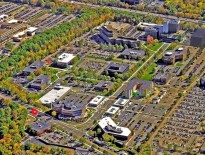One image of Gateway Cities is of old, hulking vacant mill building complexes where workers were literally “gated” in to serve the manufacturing process. That’s increasingly the wrong picture.
For years now, Massachusetts’s Gateway Cities have been making physical and economic gains. Demographic and social trends, and cultural shifts – like the attractiveness of urban conveniences to both young professionals and empty nesters – have helped.
Gateway Cities are broadly defined as midsize urban centers that anchor regional economies, but face difficult economic and social challenges. In Massachusetts, there are 26 designated Gateway Cities, and most of them were home to major manufacturing companies throughout the early and mid-20th century. As a result of multiple factors, including globalization and automation, most of those factories closed, and the regional economies they anchored were left decimated.
Over the past few decades, a variety of state and federal programs, as well as local tax incentives, have been established to help attract private sector investment into these communities. Federal programs, such as the historic tax credit, the New Markets tax credit, and the low-income housing tax credit, have been among the most impactful. State historic tax credits have also helped.
As result of these programs, billions of dollars have been invested in both residential and commercial development in Massachusetts’ Gateway Cities, and a number of similarly situated communities across the country.
Success In Lowell
The evidence that these programs are successful can be seen in cities such as Lowell, which now has a vibrant downtown featuring highly attractive market rate and affordable housing, and a diverse offering of restaurants and retailers.
Lowell was a city that had been devastated by the loss of manufacturing businesses. But, over the course of three decades, local tax incentives, smart zoning policies and perseverance have made it possible for WinnCompanies and many other developers to transform the deteriorating warehouses and factories of yesteryear into the prime commercial, office and residential real estate that exist there today.
Those revitalization successes, coupled with attractive real estate investment conditions, recently led a major company, Kronos, to move its corporate headquarters to Lowell, and bring along hundreds of new jobs in the process. Our company also moved more than 125 jobs to Lowell and we are the process of preparing space for more.
To continue to build Gateway Cities communities, continued public support for the programs that work, and programs that promise to, is required. We trust that the incoming president and his team will enthusiastically keep them intact, and maybe even expand on their success.
On the state level, one new program worth highlighting is the commonwealth’s Workforce Housing Trust Fund. The program, signed into law last year by the Baker administration, establishes a $25 million fund to support the development of middle-income rental housing in Gateway Cities. MassHousing, the state’s quasi-public housing lender, has also poured enormous resources into housing in these communities.
Gateway Cities also can benefit from more federal and state resources for commercial development.
Increasingly, Gateway City mayors and other municipal leaders want job growth – and for good reason. They want to capture some of the activity generated in Boston, Cambridge and the inner-ring of suburbs. The business dilemma is how to bridge the financial gap from what it costs to build and what commercial rent levels can support in terms of capital.
A new state program that mirrors the federal New Market tax credit program would have significant impact in helping bridge this inherent gap. We hope the Commonwealth considers this kind of initiative in the near future. The evidence that it will work can be found in the parallel historic tax credit, which lit the fuse for the blossoming redevelopment of our Gateway Cities not long after it was created more than a decade ago.
Let’s do it again, this time for commercial properties. With continued support from the public sector, private sector investment in Gateway Cities is likely to grow, making them gateways of opportunity for their residents and for businesses.
Larry Curtis is president and managing partner of WinnDevelopment.




 |
| 





